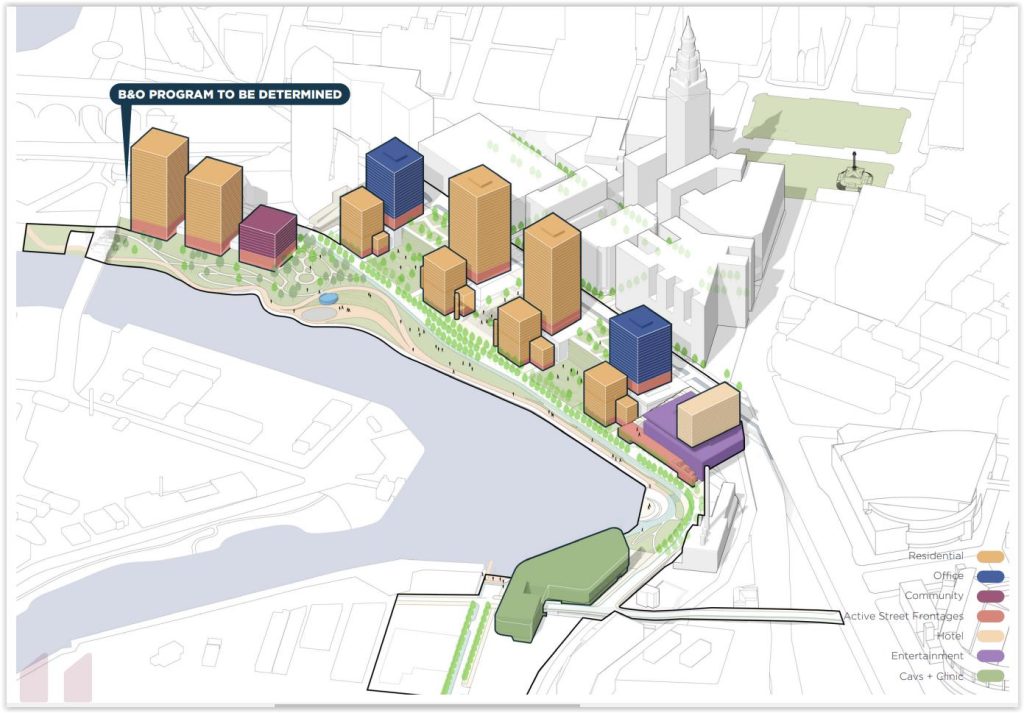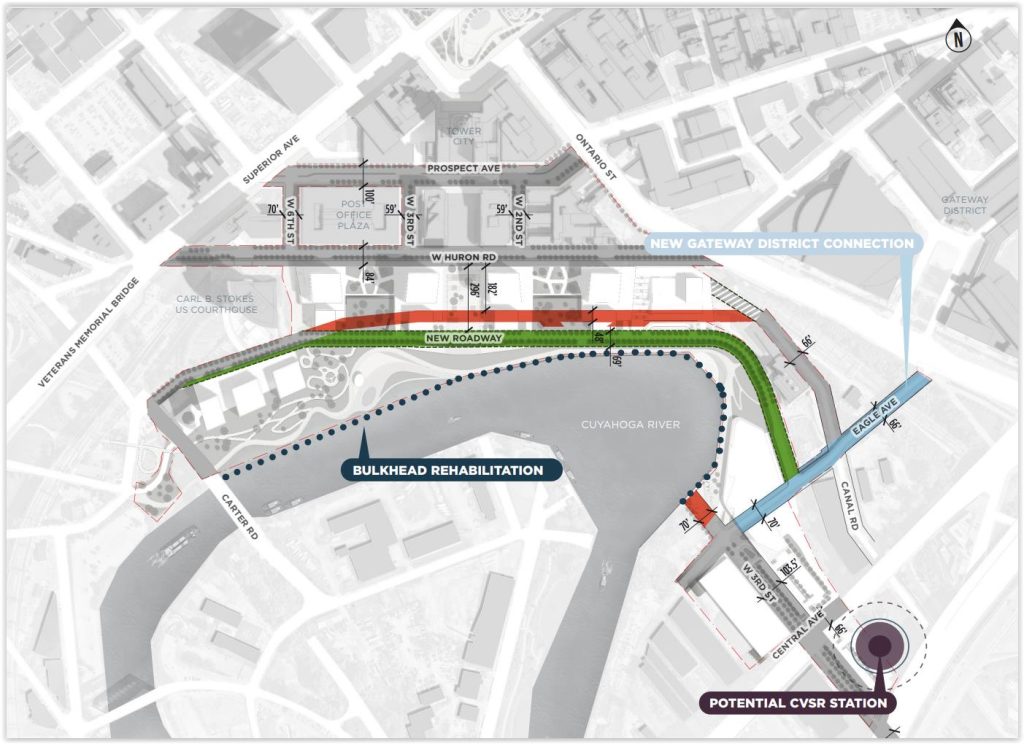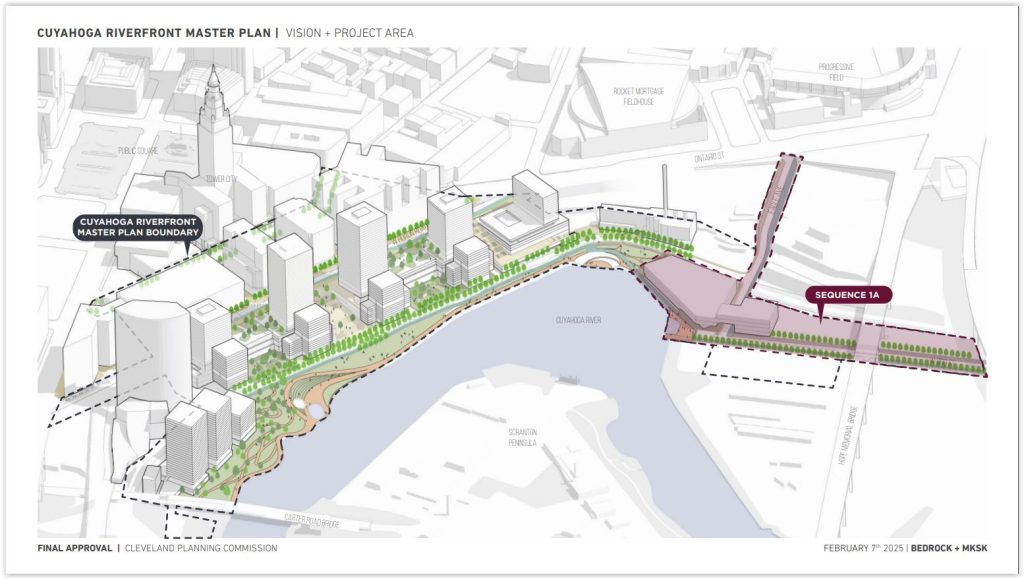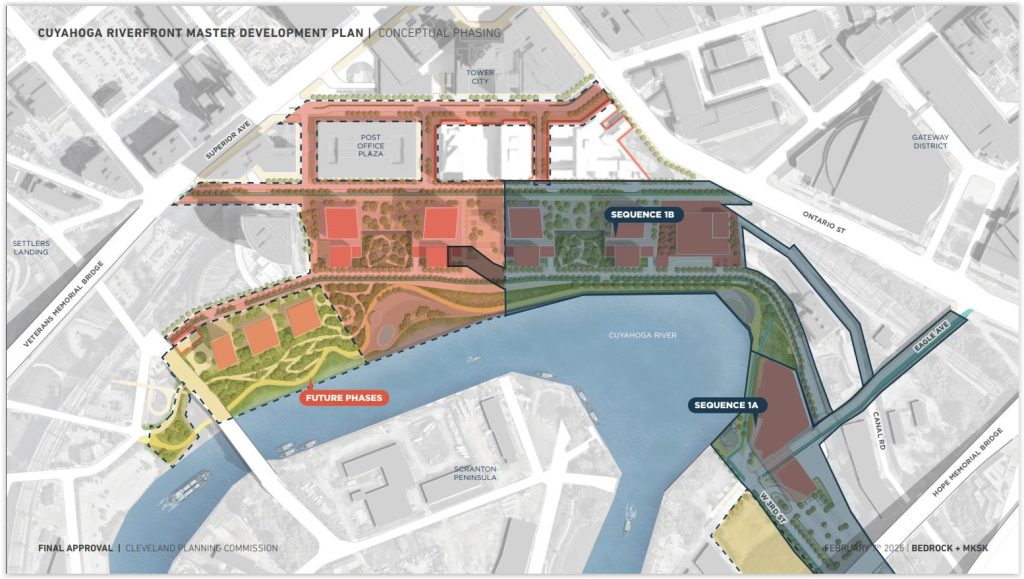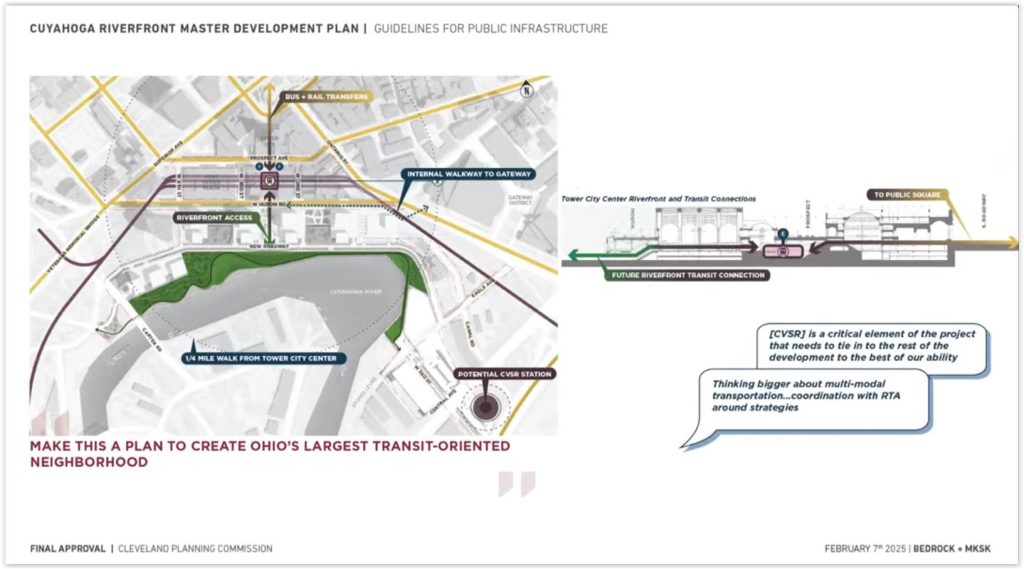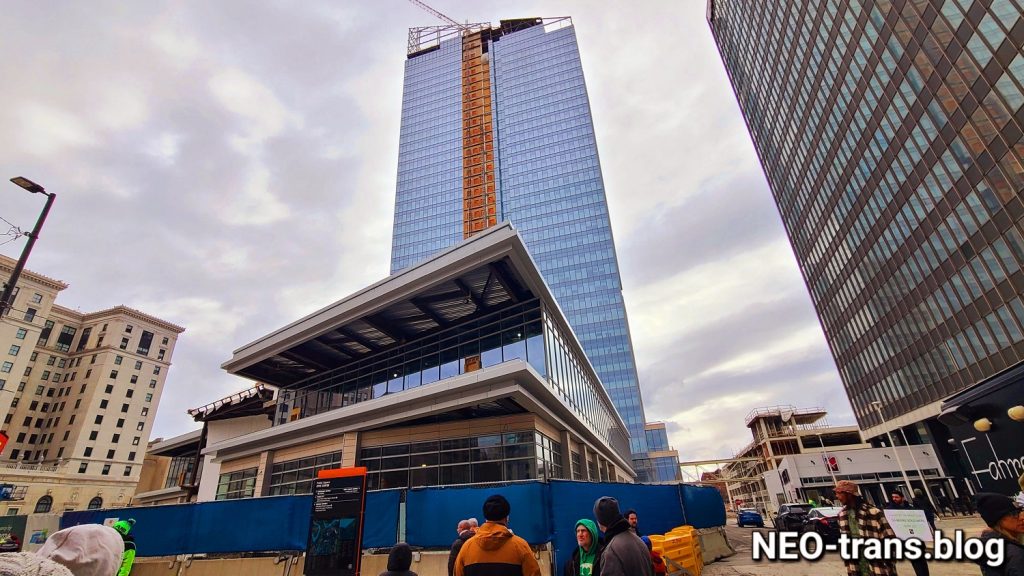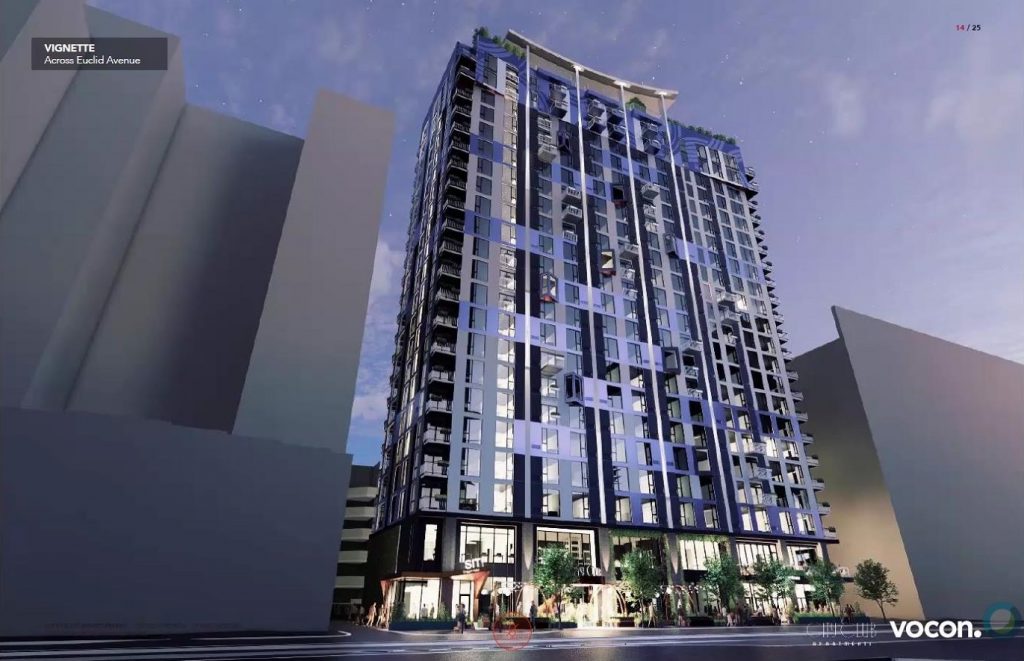Roles of Tower City, mobility are questioned
A design review panel of Cleveland’s Planning Commission today approved Bedrock’s final masterplan for its multi-phase, $3.5 billion riverfront development. But while the vote was unanimous, commission members asked some pointed questions about how all of its components would successfully come together.
Representatives of Bedrock and its design team, including Columbus-based MKSK and Cleveland-based Bialosky, told committee members that the masterplan represents two years worth of work to provide an architectural guideline for the development’s various phases to follow.
The plan was developed with input from City Planning Commission staff, said Nora Romanoff, Bedrock’s vice president of business development. She reminded the committee that a more conceptual version of the masterplan was approved by the same committee in July 2024. This final version put a finer point on the plans.
“We really see this as a partnership with the city of Cleveland,” Romanoff said. The city is also considering advancing to Bedrock proceeds of a $1 billion tax-increment financing agreement to move the infrastructure work forward more quickly so development can follow sooner.
“We want to create an 18-hour neighborhood and utilize existing infrastructure to leverage new commerce, housing, entertainment and recreation,” said Jeff Pongonis, principal landscape architect at MKSK. “The goal of this plan is to provide guidance and not be a prescriptive path for the neighborhood.”
Cullen Meves, an associate landscape architect and planner at MKSK, said that infrastructure is a foundational key to development of the riverfront plan. That includes rehabilitation of the riverfront bulkheads, with the first installations now complete. She said they are now working with the city restoring Eagle Avenue to link to the Gateway District and connect Ontario and West 3rd street.
And, realignment of a new roadway closer to the Cuyahoga River from its the current position of Canal Road will “unlock development parcels.” A new service road to access parking decks, loading docks and Dumpsters will extend west from a vacated Canal Road below a partial underpass of the Greater Cleveland Regional Transit Authority (RTA) tracks. It will be hidden below future buildings along Huron Road.
Meves described the riverfront development as Ohio’s largest transit-oriented development because of its connection to the RTA’s rapid transit station at Tower City Center, a mall fashioned in 1990 from the former Cleveland Union Terminal railroad station, and the bus hub on Public Square.
“Obviously, looking to be a transit-oriented neighborhood is a key to this plan, and unlocking the connection to the RTA station under Prospect and providing that connection there but also is a primary component of the Public Square to Tower City to riverfront design that is ongoing and is a backbone of this plan for how it is organized.”
She also said another component could be tying the riverfront development into a potential Cuyahoga Valley Scenic Railroad (CVSR) station below the Lorain-Carnegie Bridge, off West 3rd. The Planning Commission accepted public comments during this planning work. Of 57 comments received, roughly half were about the CVSR.
Dan Shinkle, the city’s principal planner on major projects and public realms, said the public responses wanted CVSR trains extended to Downtown Cleveland and specifically into Tower City Center. The high response rate on that subject was likely to due to it being a hot-button issue; a feasibility study on CVSR’s downtown extension was recently completed, led by the Northeast Ohio Coordinating Agency.
Construction is already underway on Bedrock’s riverfront development. A component of the first phase, the Cleveland Clinic Peak Performance Center that includes a practice facility for the National Basketball Association Cleveland Cavaliers, was broken out so it could be pursued now. Construction began last fall.
The next design components to come up for review by the city will likely be a kayak launch at Collision Bend on the Cuyahoga River, a riverwalk pedestrian promenade and streetscapes along Eagle Avenue and West 3rd Street. Romanoff said those public realm elements will be brought to the commission “in the very near term.” After that, she was hesitant to say when a next step might happen.
“We will come back (to planning commission) once it’s determined together with the city, the next likely sequence which is (phase) 1B,” Romanoff said.
That phase, a $488 million, 17-story entertainment complex topped by a hotel dubbed Rock and Roll Land, got a financial boost last week when it won a $9.1 million Transformational Mixed Use Development tax credit from the state of Ohio. But Bedrock had requested $40 million for the project.
“This vision is incredibly powerful,” said committee Chair Lillian Kuri. “It’s as big or bigger than Gateway in terms of what it represents for the city.”
But Kuri and Vice Chair August Fluker also said that, as big as this vision is, it raises other questions that are outside the scope of the plan. While it is assumed that the new commercial and residential uses planned for the riverfront development will bring more foot traffic to the ailing Tower City Center, they asked what programming, tenants and mobility connections does Bedrock want for Tower City?
“I walk through there every day to go to work and I kinda can’t believe it,” Romanoff said. “So what has remained the same is that Tower City is the primary source of entry to this development. It will serve as a connection to and from the rapid transit lines that we co-host together with RTA as well as the hub of Public Square. It also creates a primary backbone to not only our shore-to-core vision but also the mayor’s shore-to-core-to-shore vision that we partner with the city on.”
She praised Bedrock for keeping Tower City clean and well-maintained. But she said retrofitting it with new programming and tenants is an evolution.
“We just last week pulled our full strategic team together to talk about how that (evolution) continues to be a priority,” Romanoff added. “We are looking at ways to take an existing structure and to make sure that we use it to its highest and best use in terms of the current tenants of Tower City. We’ve also tried to maintain what they need. And in terms of design, program and tenants, that is very much an ongoing conversation at Bedrock.”
“If we don’t figure out how people move in an around downtown, and how we get people to Tower City as opposed to just driving, and it’s not just driving, then we have an issue,” Fluker said. “When we start looking at how this stuff connects, what’s that connective tissue that’s going to tie all this together? We have good parts. But what’s going to pull it all together? We need to be cognizant of that.”
“We worked with the city quite a bit on the companion documents that include a mobility study but (they) sit, and I hate to say it, almost an appendix of our appendix,” Romanoff responded.
END

